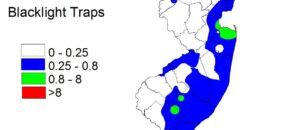White mold, or timber rot, is caused by the soil-borne fungal pathogen, Sclerotinia sclerotiorum. The photo on right shows a high tunnel tomato plant with main stem infected by white mold. Over time the entire plant will slowly collapse looking similar to a wilt or root rot pathogen as the water supply is cut off […]
Continue reading...Tree Fruit IPM Report for June 30, 2022
Peach: Oriental Fruit Moth: A biofix point for OFM was set on 4/11 in southern counties, and on 4/14 in northern counties. The second generation timings are updated below. Insecticide Type County/Region Degree Days by 6/30 base 45 Conventional 1150-1200 1450-1500 Diamide 1075-1150 1375-1450 Gloucester – Southern 1522 1st –past 2nd –past 1st –past 2nd […]
Continue reading...USDA June Acreage Report for Corn, Soybean and Wheat
The USDA released its June Acreage Report Here are the numbers: 2022 Corn Intended Acres: 89.9 million acres compared to the USDA March 31 report of 89.5 million acres and 93.3 million acres in 2021. This would be down 400,00 acres from the March report and down 3.4 million acres from last year. 2022 Soybean […]
Continue reading...Recognizing Angular Leaf Spot in Cucurbits
Angular leaf spot is common in New Jersey and the region. It often shows up during cooler, wet weather and isolated rain. Angular leaf spot will first appear as, small water-soaked lesions which will expand until they reach a larger leaf vein resulting in the angular looking symptoms on […]
Continue reading...Vegetable IPM Update 6/29/22

Sweet Corn Low numbers of European corn borer (ECB) moths remain a sporadic, low component of blacklight trap catches. Feeding in whorl and pre-tassel stage is now less common, as control has been applied to infested plantings and later blocks (now in whorl stage) have avoided most of the egg laying period. Slightly higher adult […]
Continue reading...Preparing for Anthracnose and Alternaria Leaf Blights in Cucurbit Crops
Anthracnose and Alternaria leaf blight can become problematic in cucurbit crops during long periods of wet, humid weather. Both can cause significant losses if not controlled properly. With the production season in full swing, now is a good time to review a few of these important diseases.
Continue reading...